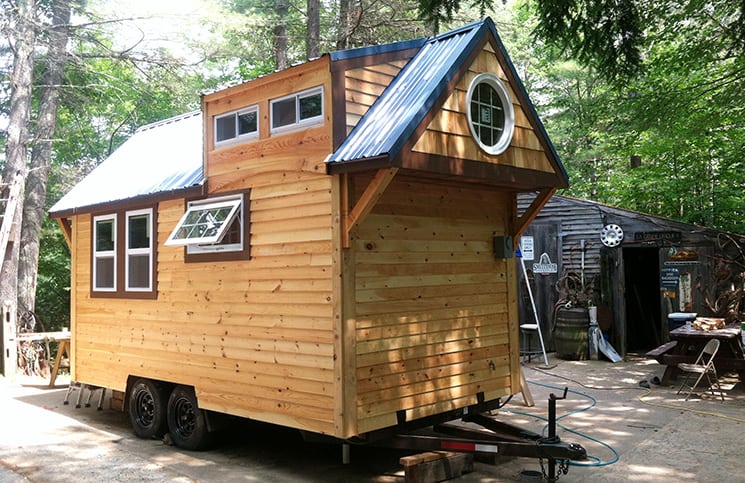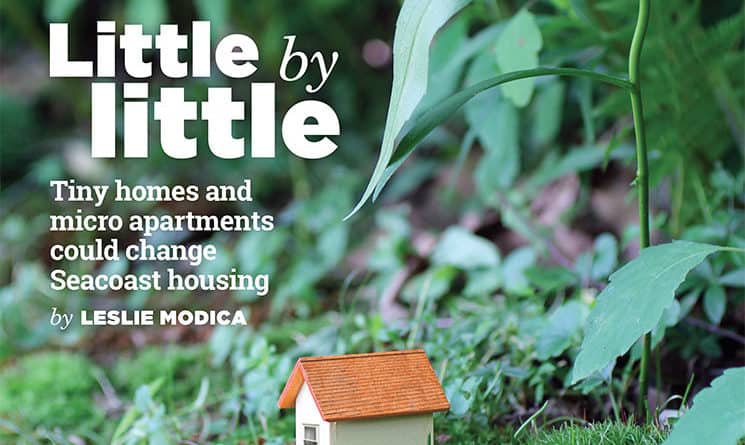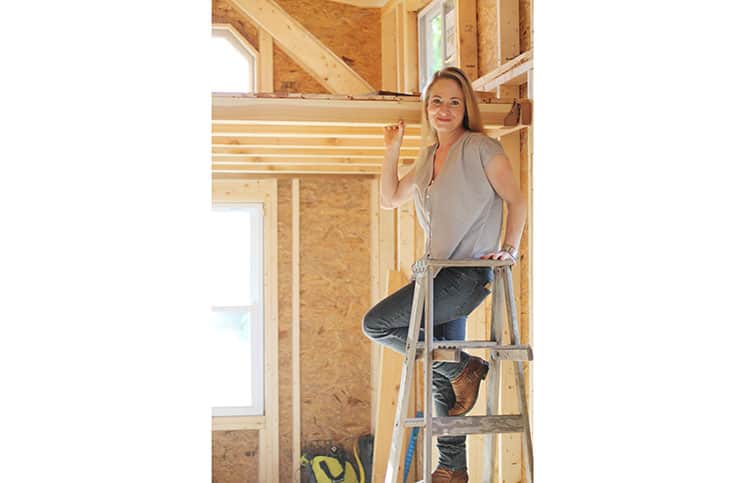When Abby Ross talks about the tiny home she’s building in Kittery, Maine, she quotes a Carole King song: “Way over yonder is a place that I know, where I can see shelter from hunger and cold. And the sweet-tastin’ good life is so easily found…Way over yonder, that’s where I’m bound.”
Ross calls her new home Yonder Tiny House.
“At the personal level, tiny houses are important because they create a much needed bridge between several paradoxical sides to human nature,” she said. “They give us freedom even as they encourage us to return to smaller, closer communities.”
It’s difficult to pinpoint the genesis for ultra-small living. Some credit Sarah Susanka, an architect who published “The Not So Big House” in 1997; others look further back to Henry David Thoreau’s “Walden.”
Modern tiny homes take many forms. They range in size from 80 to 400 square feet. The most common size is usually around 220 square feet (the size of Ross’ home), and all feature creative uses of space: sleeping lofts, steps that double as storage, and so on. Most incorporate environmentally friendly elements, like solar panels and composting toilets.
This type of living was once mostly coveted by environmentalists seeking to have a smaller footprint. But the housing market crash and Great Recession helped introduce tiny houses to a wider audience seeking something else: affordability.
Now, the once-radical idea has reached mainstream popularity. The Netflix documentary “Tiny” follows a man building his own tiny house, and there’s the FYI channel’s “Tiny House Nation.” The Internet is bursting with blogs about tiny home life. There’s even a dating site for people who own tiny homes (tinyhousedating.com).

Pete Dellea of Mapleridge Workshop is building this tiny house for a client in Lebanon, Maine. (photo by Pete Dellea)
The trend has spawned a parallel movement in cities: micro apartments. Like tiny homes, these apartments are usually smaller than 400 square feet and feature clever design elements. Unlike tiny homes, micro apartments are predominantly in urban centers and targeted toward renters, not aspiring homeowners.
In New England, micro apartments have received attention in Boston, where they went on the market in the Seaport District in 2013. Now, Portsmouth is looking at micro apartments of its own. No details have been set, but micro apartments could be part of a development around the new Deer Street parking garage. The apartments would act as a liner around the parking garage, shielding views of the garage and providing additional housing options in the downtown core.
For decades, the average home size has been growing. According to U.S. Census data, the median home size grew by nearly 1,000 square feet between 1973 and 2013, when home sizes reached an all-time high of 2,491 square feet. That number dipped slightly in 2014 to 2,453 square feet, but that’s still more than 11 Yonder Tiny Houses.
But the tide seems to be turning.
“You see a lot … of people that recognize it takes a lot to keep and clean and maintain a 3,000-square-foot house,” Dover planning director Chris Parker said. “It’s for the same reason people in the ’60s lived in 1,000- or 1,200-square-foot homes: you don’t need a lot of stuff to fill it. It costs less from an energy efficiency standpoint. There is a drive for that.” In fact, Parker said, when Dover embarked on a series of community input sessions as part of its master plan update process, the top issue was a desire to live in smaller homes.
Smaller is cheaper
Ross estimates the final cost of her tiny home will be $23,000. In an effort to remain environmentally conscious, and with a nod to her love of vintage materials, many items, like doors and windows, have been salvaged or bought second hand. Also, she has an invaluable asset: her stepfather, David Peyser, a builder by trade; they’re doing most of the building themselves.
The most expensive model from the popular Tumbleweed Tiny House Company is $69,000. It seems pricy, but it’s miniscule compared to the $359,900 median purchase price for a home in Portsmouth in 2014.
“For me, the most important aspects of the tiny house are security and independence.” — Abby Ross
Those prices appeal to a growing population of people who have become debt-shy after realizing the burden of student loans.
“(New Hampshire has) the highest college debt in the nation,” said Robin Comstock, executive director of the Seacoast Workforce Housing Coalition. “Studies show this current generation of college graduates are getting married later and having children much later than previous generations. If college kids are graduating with high levels of debt, they are working to pay that off, however they are living.”
By living small, other costs naturally go down. It’s a lot cheaper to heat 220 square feet than 2,000 square feet. All this leaves one wildcard that could curb the tiny home movement as it reaches the Seacoast: the cost of land. Out west, where land is plentiful and often cheap, tiny homes have taken off. But, in the Seacoast, land is at a premium. Zillow, a popular real estate listing website, shows the cheapest piece of land for sale in Portsmouth is a half-acre plot on Central Avenue for $275,000.
“Tiny houses are a great idea, but I don’t think it will work in Portsmouth because of the land values, combined with the zoning requirements,” Portsmouth planning director Rick Taintor said.
Taintor thinks micro apartments are more likely in Portsmouth’s future. In that case, the land cost would fall to a developer. Still, there is no guarantee micro apartments will be cheap. Many of the micro-housing units in Boston are costly — as much as a reported $1,700 per month, according to one WBUR story.
In fact, there is already some evidence of this in Portsmouth, where sub-400-square-foot apartments already exist. A 270-square-foot unit on Middle Street is listed on Craigslist for $1,200 per month. Another downtown studio, this one 500 square feet and furnished, is listed for $1,895.
A way of life
Affordability is not the only reason to live small. “Financials weren’t my first motivation,” Ross said. “For me, the most important aspects of the tiny house are security and independence.”
Ross started looking at tiny homes after she began caring for her mother, who broke her neck while walking her dog and was severely paralyzed.
At the time of the accident, Ross was 29 and living in Tempe, Ariz. Within two hours, she was on a plane heading back to New England. She went from living in her own apartment to living part-time in a hospital to living in a small house with her mother, stepfather, and grandmother.
After two years of cramped quarters, Ross needed a long-term plan. She has to be close by to care for her mother, but, as she says, she also needs to use the bathroom without somebody asking her if she bought milk.
So, Yonder Tiny House is only a little yonder for now. It’s in the backyard of the family’s main house. And she won’t be living in it full time, although she hopes to one day. When she is finished building this fall, she’ll have a sanctuary. A place to read in silence. A place to entertain friends. A place to make


